Toilet blockages are a frequent home issue that may be quite inconvenient and uncomfortable. Several things, such as flushing things that shouldn’t be flushed, a buildup of toilet paper, or an obstruction in the plumbing system, might result in a blocked toilet. While it would be tempting to call a plumber right away, you can frequently handle unclogging a toilet on your own with the correct equipment and methods.
The steps to unclog a toilet and get it back in working order are described in this guide. We’ll go through the gear you’ll need, such as a plunger and a toilet auger, and we’ll lead you through the process of unclogging a toilet step by step. It is crucial to remember that some blockages can need professional help, especially if they are brought on by more serious plumbing problems. However, with a little perseverance and the appropriate equipment, you can often remove the obstruction on your own.
Even though clearing a clogged toilet can be a messy and unpleasant chore, it must be done right away to stop future harm. Your bathroom floor may become wet from a clogged toilet, which could result in water damage and an unclean atmosphere. This guide’s instructions will help you unclog a stuck toilet without spending a fortune on repairs or hiring a pro.
15 DIY Steps to Unclog a Toilet
1. Disconnect The Water Supply
In order to unclog a toilet, turn off the water supply first. This stops water from overflowing and results in additional bathroom damage. The water supply valve must be found; it is usually near the floor or on the wall behind the toilet. Once you’ve located the valve, turn it counterclockwise to totally turn off the water supply.
This will guarantee that no additional water will enter the toilet bowl as you try to remove the obstruction. Once you’ve fixed the toilet, don’t forget to turn the valve back on to replenish the water supply.
2. Prepare The Equipment
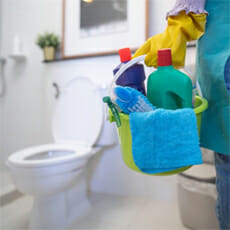
Rubber gloves are necessary to shield your hands from any potential bacteria or germs, and a pail can be used to catch any spilled water during the operation. To be ready for any circumstance that may develop, it is crucial to have this equipment on hand before attempting to fix a blocked toilet.
3. Use A Plunger
A plunger is frequently the first tool used to unclog a toilet. Place the plunger over the toilet drain after making sure it is fully submerged in water, then pump it up and down to produce suction. Since toilet plungers have a larger rubber head than sink plungers, it’s crucial to utilise one of those.
If more than one attempt is required, be patient. Before using the plunger once more if the obstruction persists, consider pouring some hot water into the bowl. Continue with alternative techniques, such as using a toilet auger or a solution of baking soda and vinegar, if the plunger method doesn’t work.
Also read: Why Won’t My Toilet Unclog With a Plunger?
4. Try Hot Water
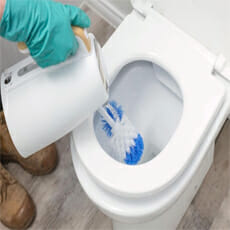
If the obstruction still persists, try a toilet auger or vinegar and baking soda solution. To prevent burns, always exercise caution when working with hot water. Also, switch off the water supply before starting any repairs.
5. Use A Toilet Auger
A toilet auger can be used to remove a difficult clog in the toilet drain if the plunger is ineffective. To remove a blockage using a toilet auger, place the auger into the drain and crank the handle. When using an auger, it’s crucial to use caution to protect the toilet.
When you encounter resistance, slowly insert the auger and turn the handle in a clockwise direction. Next, twist the handle in the opposite direction to release the obstruction. To check that the toilet is functioning properly after the obstruction has been removed, flush it.
6. Use Baking Soda And Vinegar
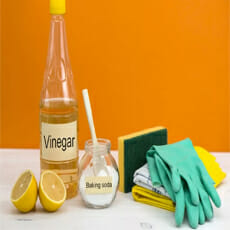
Baking soda and vinegar react, which can aid in clearing the toilet bowl of mineral buildup and other obstructions. If more than one attempt is required, this approach can be used to unclog a toilet without using harmful chemicals.
7. Check The Toilet Trap
The first step in clearing a clogged toilet is to inspect the toilet trap. The bathroom is shielded from sewage gas by the toilet trap, a bend in the toilet’s drain line that collects water. Paper towels, toys, and feminine hygiene products can occasionally become stuck in the trap and clog it.
Use a mirror to see into the drain to check the toilet trap for any obvious obstructions. Use a wire hanger or another instrument to get rid of the obstruction if you can see it. If the obstruction is not apparent, it can be deeper in the drain line and require the use of a plumbing snake to clear it.
8. Snake The Drain Line
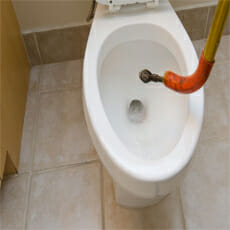
Place the plumbing snake’s tip into the toilet drain and spin the handle to guide it down the drain. Once you’ve located the obstruction, keep spinning the handle to dislodge and remove it.
To protect the plumbing system and toilet bowl, it’s crucial to use a plumbing snake gently. To check that the toilet is functioning properly after the obstruction has been removed, flush it.
9. Clean The Toilet
When unclogging a toilet, cleaning it is a crucial first step. After the obstruction has been removed, it’s crucial to disinfect the toilet bowl using a cleanser to get rid of any bacteria or odours that might have accumulated. By doing so, you can avoid clogs in the future and keep the lavatory clean.
To stop the transmission of germs, it’s also crucial to clean any tools used throughout the procedure, like the toilet auger or plunger. After clearing a blockage, you should take the time to thoroughly clean the toilet to maintain a clean and hygienic environment in your bathroom.
10. Restart The Water Supply
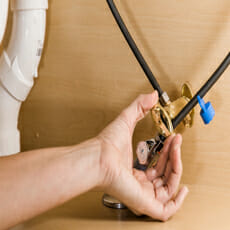
If there are any leaks, either replace the damaged components or tighten the bolts holding the tank to the bowl. Reattach the toilet cover and properly dispose of any waste after everything is operational. Finally, give your hands a good soap and water wash.
11. Flush The Toilet
After attempting to remove the obstruction, flushing the toilet is a crucial step in clearing a blocked toilet. This will let you check whether the obstruction has been cleared and the toilet is now operating normally.
Flushing the toilet could cause it to overflow if the obstruction has not been removed, which could result in water damage and create an unhealthy atmosphere. Before flushing the toilet, be sure the clog has been successfully removed by moving slowly and taking the preceding steps.
12. Check For Leaks
When clearing a blocked toilet, checking for leaks is crucial. It’s crucial to look for leaks near the toilet bowl and tank after the obstruction has been removed and the toilet has been flushed. Check the floor and the area around the toilet’s base for any evidence of water.
Make sure the connections between the tank and the bowl are tight and stable by inspecting them. If there are leaks, tighten the connections or, if necessary, replace any broken pieces. You can make sure the toilet is working properly and stop any further water damage by looking for leaks.
If you need plumbing services that can check and repair any toilet leaks. Check these links below:
13. Put The Toilet Lid Back On
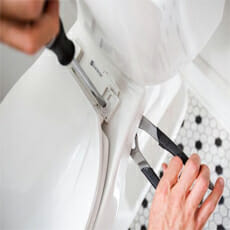
To maintain correct operation and avoid any potential safety issues, replace the lid with a new one if it was cracked or damaged during the process of clearing the obstruction. Reattaching the toilet lid is a quick but crucial step in clearing a toilet obstruction.
14. Throw Away Waste Materials
An important first step in unclogging a toilet is proper waste disposal. Once the obstruction has been removed, it’s critical to properly dispose of any leftover waste to avoid additional blockages and to preserve hygienic conditions. Dispose of any non-flushable things that may have contributed to the obstruction, such as feminine hygiene products or wipes, in a rubbish bag.
It’s crucial to properly drain the water used to remove the obstruction, preferably in a toilet or washbasin. Inadequate waste disposal can result in additional clogs and unhygienic conditions in your bathroom.
15. Wash Your Hands

Spend at least 20 seconds thoroughly cleaning your hands, being careful to get in between your fingers and under your nails. Dry your hands with a clean towel or an air dryer after giving them a thorough rinse with clean water. Washing your hands properly can help keep you and your family safe and healthy.
6 Ways to Unclog a Toilet Without Using A Plunger
1. Dish Soap
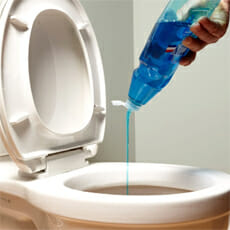
Before flushing the toilet, let the mixture stand for a few minutes. To completely remove the blockage, this process might need to be done several times.
Most households have access to dish soap, which is a secure and organic substitute for corrosive chemical cleaners. However, it is better to hire a licensed plumber if the blockage is serious.
2. Wire Hanger
The simplest but most efficient tool for unclogging a clogged toilet is a wire hanger. Straighten the wire hanger, then place one end of it in the toilet bowl and use it to either push or pull the obstruction through. Avoid using the wire hanger to scratch the toilet bowl.
Repeatedly flushing the toilet after the obstruction has been removed will guarantee that the water is flowing freely. After handling the wire hanger, don’t forget to properly wash your hands with soap and water. It is preferable to call a plumber for assistance if this approach doesn’t work or if the blockage is severe.
3. Toilet Brush
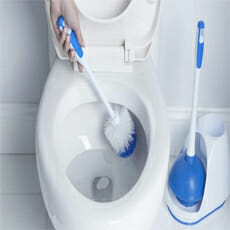
Once the obstruction has been removed, flush the toilet multiple times to make sure the water is flowing freely. It’s crucial to remember that a plunger works better for larger blockages than a toilet brush, so if the obstruction persists, you may need to try another approach or call a plumber for assistance.
4. Enzyme-Based Cleaners
A common and efficient alternative to using a plunger to unclog a clogged toilet is enzyme-based cleansers. These cleaners have natural enzymes that break down organic debris, including human waste and toilet paper, which can clog pipes. Pour the cleanser into the toilet bowl as directed, then let it sit there for the prescribed period of time.
In order to clear the drain and dissolve the obstruction, the enzymes will act. Enzyme-based cleaners often don’t include strong chemicals that can harm the environment or break pipes, making them suitable for septic systems. To prevent further harm to the toilet or plumbing system, it’s crucial to carefully follow the directions and apply the proper amount of cleanser.
5. Wet/Dry Vacuum
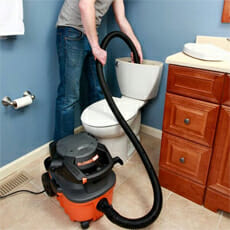
Once the obstruction is gone, turn on the Hoover and let it run for a little while. If the obstruction is extremely big, you might need to first break it up with a wire hanger or toilet brush.
To prevent splashing or messes, don’t forget to use rubber gloves and take the necessary precautions. This approach may be successful, but it is preferable to seek expert help if you are unsure of how to proceed or the obstruction is severe.
6. Plumbing Snake
An instrument used to unclog toilets and drains is a plumbing snake, sometimes referred to as a drain snake. It is made up of a long, flexible cable with an auger or coil on one end and a handle on the other. Insert the coil of a plumbing snake into the drain and turn the handle to dislodge the obstruction to use it to unclog a clogged toilet.
The barrier can be broken apart or forced through with the snake. Wear gloves to safeguard your hands and make sure to properly follow the manufacturer’s directions. When trying to unclog a clogged toilet, a plumbing snake can be a helpful substitute for a plunger.
Read more: 6 Tips to Unclog a Drain if a Plumbing Snake Doesn’t Work
Conclusion
Although clearing a blocked toilet may seem like a difficult operation, it is actually rather simple to complete with the correct equipment. It is usually preferable to obtain expert assistance from a plumber if you are unclear about how to proceed if the blockage is severe. Self-help attempts to unclog a toilet can occasionally make things worse and necessitate expensive repairs.
Always remember to properly wash your hands with soap and water after unclogging a toilet. Washing your hands properly can help stop the spread of germs and diseases.
In conclusion, a blocked toilet can be a frustrating issue, but with the appropriate equipment and methods, it can be quickly remedied. You can fix the blockage yourself to save time and money if you adhere to the instructions in this manual and take the necessary safety precautions.
You may contact Damien McEvoy Plumbing at (02) 8599 4593 if you are unsure. We’re here to help!


 Enquire
Enquire